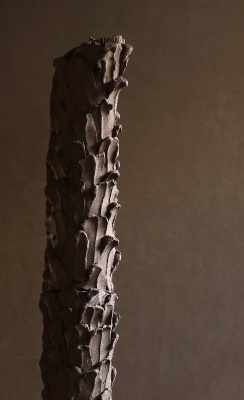Descripción de la Exposición
Alonso Berruguete (c. 1488–1561) revolutionized the arts of Renaissance Spain with a dramatic style of sculpture that reflected the decade or more he spent in Italy while young. Although unfamiliar to most Americans, and rarely featured in traditional accounts of Renaissance art, Berruguete has been revered as an icon in Spain for centuries. Organized by the National Gallery of Art, Washington, and the Meadows Museum, SMU, Dallas, in collaboration with the Museo Nacional de Escultura, Valladolid, Spain, Alonso Berruguete: First Sculptor of Renaissance Spain is the first exhibition devoted to the artist held outside Spain. About 45 paintings, sculptures, and works on paper drawn mostly from international collections will be on view in the Gallery's West Building from October 13, 2019, through February 17, 2020.
Celebrated today primarily for his expressive sculptures, Berruguete was also a skilled painter and draftsman. The exhibition presents a range of works from across the artist's career, including one of the paintings he made while in Italy, the seductive Salome (c. 1514–1517, Gallerie degli Uffizi, Florence). A group of some of his 25 known drawings is also included, each testifying to his abilities as a draftsman. The centerpiece of the exhibition is a selection of his best sculptures—all carved in wood and painted and gilded—from the retablo mayor (high altarpiece) of San Benito el Real in Valladolid, Spain, now in the collection of the city's Museo Nacional de Escultura. One section of the enormous altarpiece is loosely reconstructed in the exhibition to give visitors some idea of how the sculptures were originally installed. An accompanying film showcases those works by Berruguete that cannot travel, such as his alabaster group of the Transfiguration of Christ that crowns the choir of Toledo cathedral. Drone footage provides stunning views of these powerful works.
"The Gallery is excited to introduce American audiences to Alonso Berruguete, a Spanish cultural treasure who until now has been little known on this side of the Atlantic," said Kaywin Feldman, director, National Gallery of Art, Washington. "The exhibition brings to life the network of artists working in Castile at the time and the rich cultural exchange of the period. Together with the catalog, Alonso Berruguete: First Sculptor of Renaissance Spain will add greatly to our understanding of the multitalented artist's place in the Renaissance."
Exhibition Support
The exhibition is made possible through the generous support of the Buffy and William Cafritz Family Fund. Additional funding is provided by The Exhibition Circle of the National Gallery of Art.
Exhibition Organization and Curators
The exhibition is curated by C. D. Dickerson III, curator and head of sculpture and decorative arts, National Gallery of Art, Washington, and Mark McDonald, curator of drawings and prints, The Metropolitan Museum of Art. Curator for the Meadows Museum venue is Wendy Sepponen, Mellon Curatorial Fellow, Meadows Museum, SMU.
The exhibition is organized by the National Gallery of Art, Washington, and the Meadows Museum, SMU, Dallas, in collaboration with the Museo Nacional de Escultura in Valladolid.
Exhibition Tour
National Gallery of Art, Washington, October 13, 2019–February 17, 2020
Meadows Museum, SMU, Dallas, March 29–July 26, 2020
Exhibition Highlights
Alonso Berruguete: First Sculptor of Renaissance Spain opens with a group of paintings and sculptures representing the artistic world in which Berruguete grew up, a world dominated by artists working in the prevailing Hispano-Flemish style. Reflecting the influence of artists from Flanders and other places in northern Europe, the style is characterized by minute details, complicated patterns of angular drapery, elongated bodily features, and the use of pointed arches and other elements of Gothic architecture. Berruguete would have learned the particulars of the style from his father, Pedro Berruguete, one of the leading Hispano-Flemish painters. Pedro is represented in the exhibition with one of his most accomplished paintings, Virgin and Child Enthroned (c. 1500, Ayuntamiento de Madrid, Museo de San Isidro, Los Orígenes de Madrid).
Berruguete traveled to Italy around 1506 and is first recorded in Rome, where he met Michelangelo. Like all young artists who came to Italy, he turned immediately to studying ancient sculpture and the works of the modern masters. He moved to Florence after some time and found success there as a painter. The few paintings that survive from his time in Italy—such as Salome—demonstrate that Berruguete was one of the pioneers of mannerism, a style of exaggerated forms and supreme elegance that came into fashion during the 1510s.
In Italy Berruguete also learned to draw. He would become the first Spanish artist to create a recognizable body of drawings. Only about 25 of his drawings survive, with a large selection presented in the exhibition. He used drawings to plan his compositions and communicate his designs to assistants. These range in type from quick pen-and-ink sketches to more controlled works in chalk and other media, such as The Assumption of the Virgin (c. 1550–1560, The British Museum, London).
Most of the works in the exhibition date to after Berruguete's return to Spain in 1518. His first stop was Zaragoza, where he was invited to serve as the court painter to the newly crowned King Charles I (the future Holy Roman Emperor Charles V). Shortly after, he decided to branch out into the more lucrative field of sculpture. His focus became retablos, the traditional kind of altarpiece used in Spain that combines painting and sculpture. A selection of his best sculptures from his masterpiece as a maker of retablos is the focal point of the exhibition: the retablo mayor of San Benito el Real, the most important monastic church in Valladolid. In works like The Sacrifice of Isaac (1526/1533, Museo Nacional de Escultura, Valladolid), his radical style is on full display: figures that seem to be in constant motion, their faces contorted by intense expression. Berruguete recognized that there was a place in his native Castile for the art he had learned in Italy—an art of manipulating the human form to create heightened emotion. The exhibition also features a group of recently conserved sculptures, The Adoration of the Magi (c. 1537–1538), from a smaller retablo that Berruguete made for a private chapel in the church of Santiago Apóstol, Valladolid.
Alonso Berruguete (C. 1488–1561)
Born around 1488 in a small town in northern Castile, Berruguete spent his youth at the side of his father, the distinguished painter, Pedro Berruguete. Around the age of 17—not long after his father's death—he made the life-altering decision to move to Italy, where he remained until 1518. On returning to Spain, he first served Charles I as his painter. Eventually, he made his way to Valladolid, where he established his workshop and turned his attention to producing retablos. Berruguete produced at least a half dozen retablos for churches and private chapels over his career, including the one for San Benito el Real.
As Berruguete's fame spread, he was invited to undertake a string of prestigious commissions in Toledo. His principal patron there was the powerful archbishop, Cardinal Juan Pardo de Tavera. Some of Berruguete's most powerful works decorate the cathedral's choir, including the wood reliefs on the seatbacks. Berruguete died in 1561 as he was putting the finishing touches on the archbishop's marble tomb—just 16 years before El Greco's arrival in the city.
Exhibition Catalog
The first comprehensive account in English of Berruguete's life and art is published by the Gallery in association with the Meadows Museum, SMU; Centro de Estudios Europa Hispánica/Center for Spain in America; and Yale University Press. Support for the catalog was provided by the Centro de Estudios Europa Hispánica/Center for Spain in America. Edited by the exhibition's cocurators, C. D. Dickerson III and Mark McDonald, the catalog features essays by Manuel Arias Martínez, deputy director, Museo Nacional de Escultura, Valladolid; Daphne Barbour, senior object conservator, National Gallery of Art, Washington; Jonathan Brown, Carroll and Milton Petrie Professor Emeritus of Fine Arts, Institute of Fine Arts, New York University; Richard L. Kagan, Arthur O. Lovejoy Professor Emeritus of History, Johns Hopkins University; Wendy Sepponen, Mellon Curatorial Fellow, Meadows Museum, SMU, and formerly Joseph F. McCrindle Foundation Curatorial Fellow, National Gallery of Art, Washington; and Julia M. Vázquez, Hilla Rebay International Fellow, Solomon R. Guggenheim Museum and Foundation, and formerly Meadows/Kress/Prado Curatorial Fellow, Meadows Museum, SMU. With 175 illustrations and some 230 pages, the catalog will be available in the Gallery shops, at shop.nga.gov, or by calling (800) 697-9350 or (202) 842-6002; faxing (202) 789-3047; or emailing mailorder@nga.gov.
Exhibition Film
A film concludes the exhibition with footage of works by Berruguete too large to travel, including the choir of Toledo cathedral, the tomb of Cardinal Juan Pardo de Tavera, and the retablo mayor of the Colegio Mayor Arzobispo Fonseca, Salamanca. Funding for the film was provided by the Cultural Office of the Embassy of Spain. The film is also made possible by the National Gallery of Art, Washington, and the Meadows Museum, SMU, Dallas.
Related Programs
Lecture
Introduction to the Exhibition—Alonso Berruguete: First Sculptor of Renaissance Spain
October 13 at 2:00 pm
C. D. Dickerson III, curator and head of sculpture and decorative arts, National Gallery of Art, Washington
A signing of the exhibition catalog follows.
Concert
Music from the Time of Carlos V
Nordic Voices
February 9, 3:30 p.m.
West Building, West Garden Court
The six-voice a cappella ensemble will perform music from the 16th century during the time of Charles V, including music by Spanish composers of the era such as Tomás Luis de Victoria and Cristóbal Morales.
Conference
Alonso Berruguete and Renaissance Sculpture
November 15, 11:00 am to 3:30 pm
West Building Lecture Hall
A conference organized by the Center for Advanced Study in the Visual Arts will feature presentations by speakers including Ilenia Colón Mendoza, associate professor of art history, University of Central Florida; Kelley Helmstutler Di Dio, professor of art history, associate dean, University of Vermont; Adam Jasienski, assistant professor of art history, SMU; Richard L. Kagan, professor emeritus, Johns Hopkins University; Tommaso Mozzati, researcher, Universitá Degli Studi Di Perugia; and Wendy Sepponen, Mellon Curatorial Fellow, Meadows Museum, SMU.
Berruguete-Inspired Dining
The Garden Café presents an assortment of dishes inspired by the cuisine of Renaissance Spain featuring oven-roasted paella, Manchego and other regional cheeses, a meat platter including jamón serrano, braised octopus, seasonal ingredients, and traditional desserts. Berruguete-inspired items are available during the week (view full menu here) and weekend brunch buffet (view full menu here). Located in the West Building, the Garden Café is open Monday through Saturday from 11:30 a.m. to 3:00 p.m. and Sunday from 12:00 to 4:00 p.m. For parties of four or more, please call 202-712-7453 for reservations.

Exposición. 29 mar de 2020 - 26 jul de 2020 / Meadows Museum of Art - SMU Dallas / Dallas, Texas, Estados Unidos

Exposición. 17 abr de 2025 - 03 sep de 2025 / Centro Cultural Andratx (CCA) / Andratx, Baleares, España

Formación. 08 may de 2025 - 17 may de 2025 / Museo Nacional Centro de Arte Reina Sofía (MNCARS) / Madrid, España